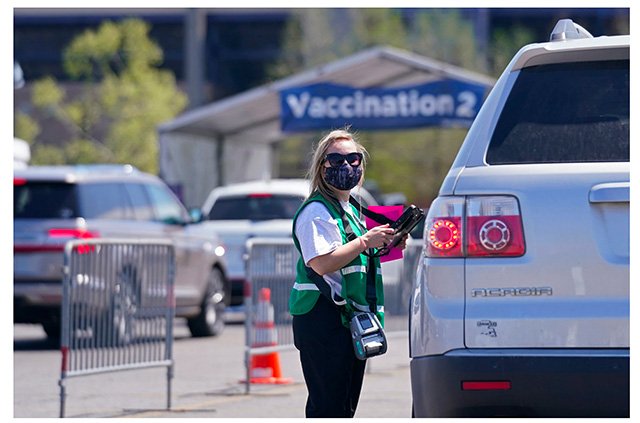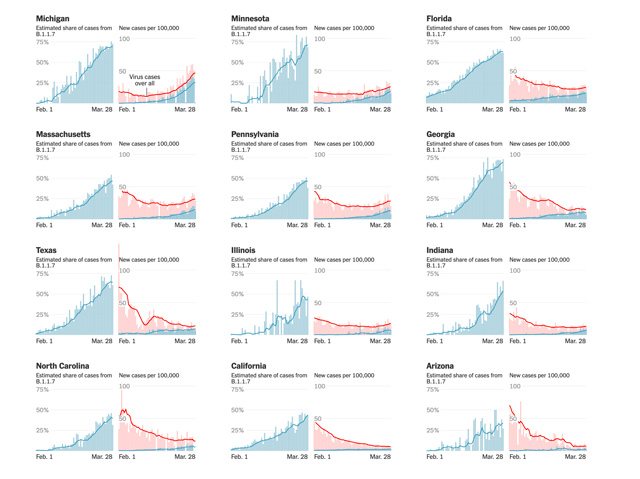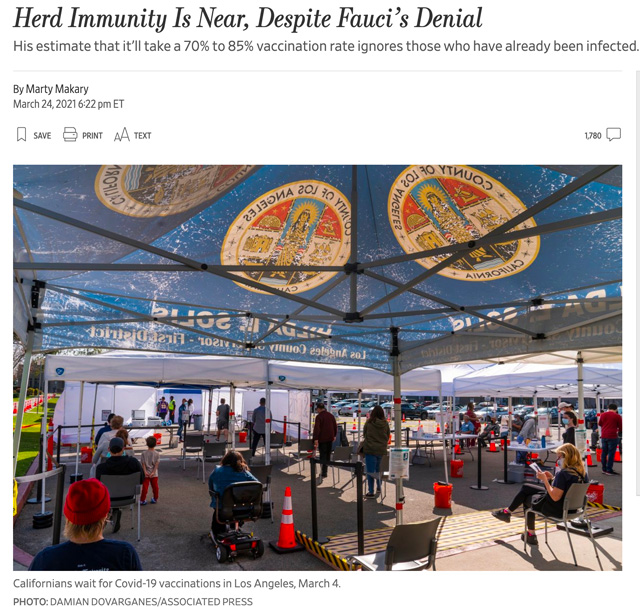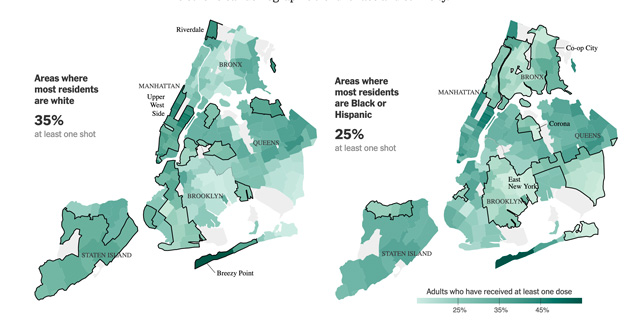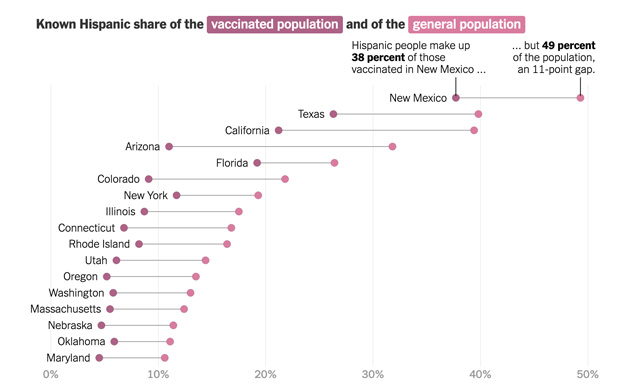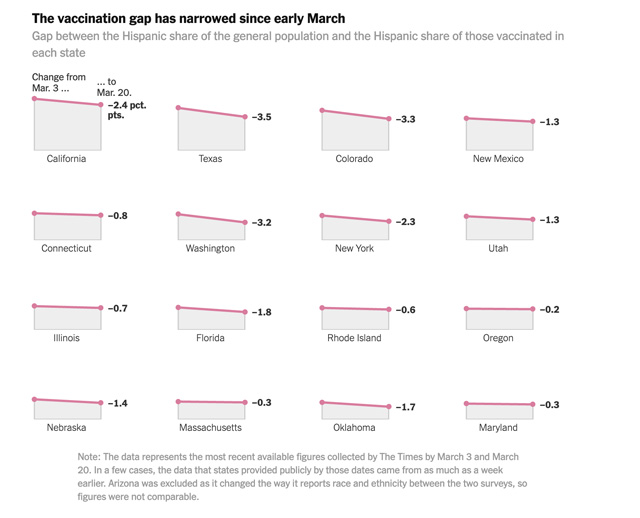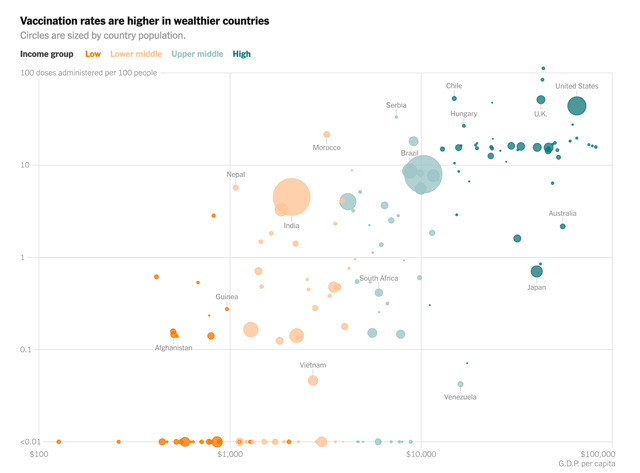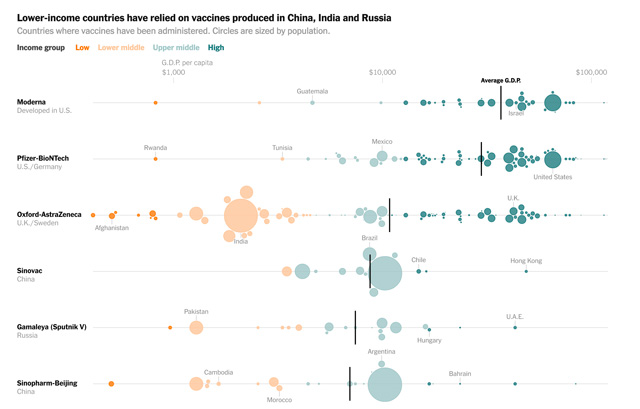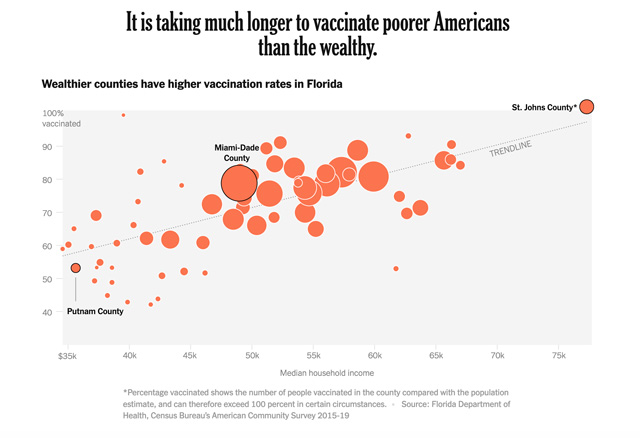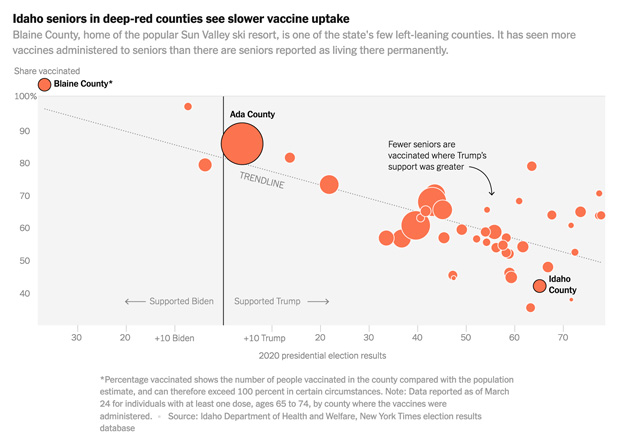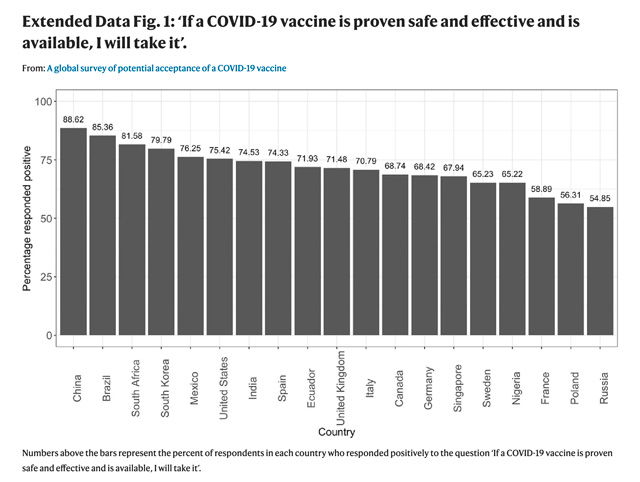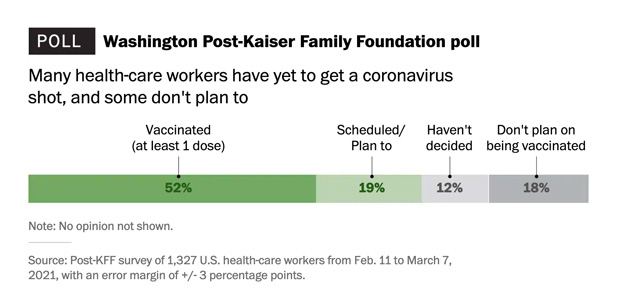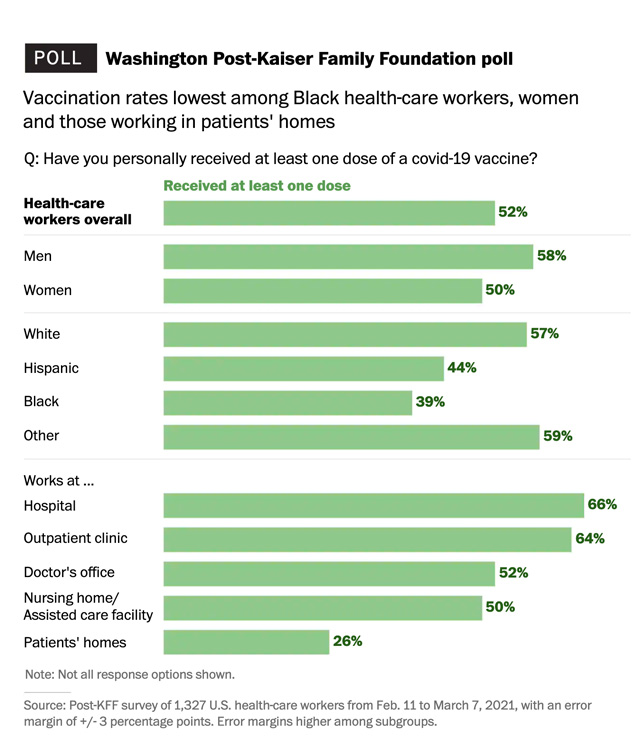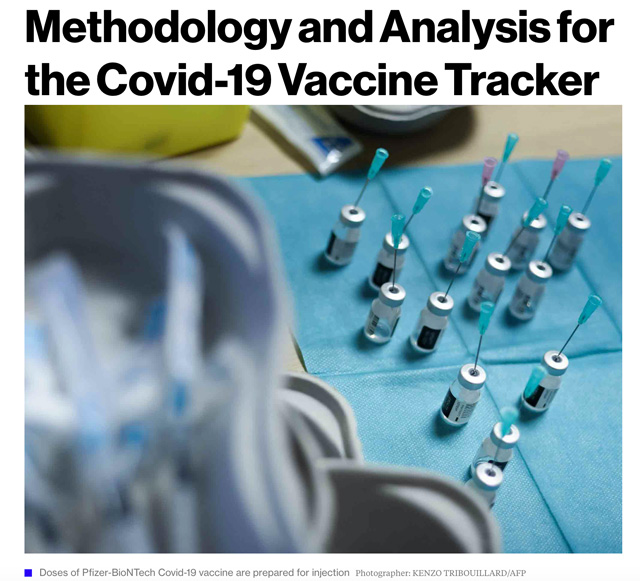Data: Covid-19 Cases & Vaccines
Cases
As Variants Have Spread, Progress Against the Virus in U.S. Has Stalled
Cases are up in states with strong variant presence.
Michigan has seen the sharpest rise in cases in the last few weeks. B.1.1.7 — the more transmissible and more deadly variant of the coronavirus that was first discovered in the United Kingdom — may now make up around 70 percent of all of the state’s new cases, according to the Helix data.
A decline in testing may be masking the spread of the virus in some U.S. states.
Declines in coronavirus testing in many states in the South and the Great Plains are making it harder to know just how widely the virus may be spreading in those states, even as restrictions are lifted and residents ease back into daily life, experts say.
States in both regions are reporting few new cases relative to their population, compared with harder-hit states like Michigan or New York. But they are also testing far fewer people.
Kansas, for example, is now testing about 60 people a day for every 100,000 in population, according to data compiled by Johns Hopkins University, and Alabama only a bit more. The picture is similar in Iowa, Mississippi and elsewhere.
By contrast, New York is averaging 1,200 tests a day per 100,000, and Rhode Island 1,677 per 100,000.
Political Battles
Here we go again with the theater’: Fauci pushes back on Rand Paul’s amateur epidemiology — again
At a Senate hearing, Paul pressed Fauci on health experts’ continued recommendation of masks even for people who have contracted the virus or who have been vaccinated. Paul repeatedly suggested wearing masks in those cases was “theater” — pointing specifically to Fauci wearing masks even though he has been vaccinated.
“You’re telling everybody to wear a mask, whether they’ve had an infection or a vaccine,” Paul said. “What I’m saying is: They have immunity, and everybody agrees they have immunity. What studies do you have that people that have had the vaccine or have had the infection are spreading the infection? If we’re not spreading the infection, isn’t it just theater? … You’ve had the vaccine, and you’re wearing two masks. Is that just theater?”
In fact, not everyone agrees they have full immunity and/or can’t spread the virus.
Fauci said that, despite the lack of reinfections thus far, we don’t have significant data in two very relevant areas: Whether people who get the vaccine or who have contracted the virus can still spread it, and whether variants of the coronavirus might override any existing immunity. He bristled at the idea that his personal use of masks was “theater.”
“Let’s get down to the facts,” Fauci said. “The studies that you quote from Crotty and Sette look at in vitro examination of memory immunity, which in their paper, they specifically say this does not necessarily pertain to the actual protection. It’s in vitro.”
Herd Immunity Is Near, Despite Fauci’s Denial
His estimate that it’ll take a 70% to 85% vaccination rate ignores those who have already been infected.
Anthony Fauci has been saying that the country needs to vaccinate 70% to 85% of the population to reach herd immunity from Covid-19. But he inexplicably ignores natural immunity. If you account for previous infections, herd immunity is likely close at hand.
Data from the California Department of Public Health, released earlier this month, show that while only 8.7% of the state’s population has ever tested positive for Covid-19, at least 38.5% of the population has antibodies against the novel coronavirus. Those numbers are from Jan. 30 to Feb. 20. Adjusting for cases between now and then, and accounting for the amount of time it takes for the body to make antibodies, we can estimate that as many as half of Californians have natural immunity today.
The per-capita rates of new COVID-19 cases and COVID-19 deaths were higher in states with Democrat governors in the first months of the pandemic last year, but became much higher in states with Republican governors by mid-summer and through 2020, possibly reflecting COVID-19 policy differences between GOP- and Democrat-led states, according to a study led by researchers at the Johns Hopkins Bloomberg School of Public Health and the Medical University of South Carolina.
Vaccine Equity
See Who Has Been Vaccinated So Far in New York City
The Vaccination Gap Among Hispanic Communities Reflects Barriers to Access
Commenter: Where’s the discussion of age in this? Different populations have different shares of the aged population, which was appropriately prioritized (at least in some states). Perhaps the very first graph could have shown the known share of the vaccinated population vs. the share of the general population over 65.
Vaccination rates are higher in wealthier countries
Will We Struggle to Reach Herd Immunity?
Within states and among equally eligible people, the richest areas are getting vaccines faster. This suggests that even if all poorer Americans seek out the vaccines, it will take a long time to vaccinate them at our current rates.
Almost all seniors in the state’s wealthiest county, St. Johns, have been vaccinated. (The numbers may be inflated because of seasonal residents, or snowbirds, who aren’t necessarily counted as part of the county’s population but are still counted among people getting vaccinated there.) But the first county west of St. Johns is one of the state’s poorest: Putnam, where the median annual income is about $35,000. Only half of the county’s residents ages 65 to 74 have been vaccinated.
Nationally, many conservatives — men in particular — have said in multiple polls that they do not wish to be vaccinated. In some of Idaho’s more conservative counties, senior vaccination rates are below 40 percent.
Vaccine Hesitancy
Data & Methodology
Bloomberg: Methodology and Analysis for the Covid-19 Vaccine Tracker
4/14/21 – Bloomberg: Saturday’s BIG Number
On Saturday, the U.S. reported a huge number of vaccinations: 4.6 million, more than 50% higher than any previous daily report.
There’s always a reason to look at big increases or decreases with caution, and today is no different.
Usually, the U.S. Centers for Disease Control and Prevention pulls their numbers from state data at 6 a.m. (Remember, vaccinations are logged under this methodology when they are reported, not when they happen.)
Today, the CDC pulled the data much later in the day, according to the agency. That’s a small methodological change that means a big (seeming) increase in doses. But it essentially robs doses from Sunday’s report, presuming CDC goes back to its normal data pull and reporting schedule.
If it had pulled the data at the normal time, today’s reported doses would have been 2.98 million, according to the agency. That’s still a big number — a record, in fact — but it’s no 4.6 million.
3/18/21 Bloomberg: People Covered
We’ve introduced a new way to measure vaccinations around the world: “people covered.” This is a calculated figure based on the number of doses administered and the mix of vaccine types used. This figure accounts for the doses required for each type of shot—some require two doses, others just one.
Here are a few examples to show how it’s calculated. Keep in mind that Pfizer and Moderna require two doses per vaccination, while J&J is a single-dose vaccination:
Pfizer: 10M doses administered = 5M people covered
Moderna: 10M doses administered = 5M people covered
J&J: 10M doses administered = 10M people covered
Previously we mostly relied on per capita doses administered when comparing the pace of vaccinations between states or countries. The introduction of J&J’s single-dose vaccine made that metric imprecise.
Blood clots
3/15/21 – Should You Be Concerned About Blood Clots, Bleeding and the AZ-Vaccine?
Millions of people in dozens of countries have received the AstraZeneca Covid vaccine with few reports of ill effects, and its prior testing in tens of thousands of people found it to be safe. But recently, blood clots and abnormal bleeding in a small number of vaccine recipients in European countries have cast doubt on its safety, although no causative link has been found between the patients’ conditions and the vaccine. The reports have prompted more than a dozen countries to either partly or fully suspend the vaccine’s use while the cases are investigated. Most of the nations said they were doing so as a precaution until leading health agencies could review the cases.
How can scientists determine whether there’s a link?
One indicator to look at is incidence. Blood clots in general are so common that it is expected that a certain number of people will get them for various reasons at any given day of any given week. If someone has had a vaccine and then develops a blood clot, it doesn’t necessarily mean the shot caused the clot.
After initial reports of clotting last month, AstraZeneca was quick to point out that the incidence of clots overall is lower in people who have received the shot that in the general population, in the countries that is using the shot.
An AstraZeneca spokesperson said in a statement to CNN on Friday: “Patient safety remains the Company’s highest priority,” and pointed to a
uathorities in the UK, EU and the WHO’s recommendations to continue its use.
“The benefit risk profile of the vaccine was reaffirmed in the EMA’s monthly safety update,” the spokesperson said.
